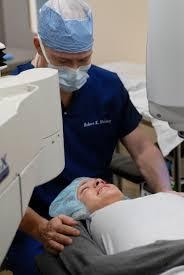An eye surgery treatment called laser-assisted in situ keratomileuses (LASIK) can significantly enhance your eyesight. It permanently alters the form of the tissue at the front of your eye, and these modifications persist for the rest of your life. However, as part of the normal aging process, most people’s eyesight deteriorates with time. Because eye surgery LASIK cannot prevent this from happening, your vision may become blurry again as you grow older.

The length of time that these changes take place after your eye surgery LASIK will be determined by your age at the time of the procedure and whether or not you have any other progressive eye diseases.
This laser technique is performed on around 700,000 people each year to restructure the cornea so that light going through it is appropriately focused on the retina. After the surgery, which was initially authorized by the Food and Drug Administration (FDA) in 1998, around 96 percent of patients will have the vision they seek, according to the FDA.
If you or someone you know is considering having eye surgery LASIK, it’s critical to understand not just the advantages and risks of the process itself, but also the financial implications of the procedure.
The typical cost of eye surgery LASIK is roughly $4,200 in total, however, it can be significantly less. In addition to the surgery itself, preoperative examinations and postoperative follow-up exams are frequently performed as part of this.
Additionally, a follow-up surgery known as LASIK enhancement may be included in the price if too little tissue was removed during the original procedure. LASIK enhancement might help you see better in the long run if you have trouble seeing clearly in the short term.
Because eye surgery LASIK is considered an elective operation, it is not covered by most health insurance plans in Australia.
Is eye surgery lasik covered by health insurance?
The simple answer to this question is “no.” Most insurance companies consider eye surgery LASIK and other corrective laser eye operations to be elective procedures, and as a result, they do not provide coverage for these procedures. However, there are some instances in which your insurance company will pay refractive or laser eye surgery, such as when it is required to rectify mistakes as a consequence of an injury or surgical procedure.
What is the price of eye surgery lasik?
Because you will be paying for eye surgery LASIK out of pocket, it is critical that you be aware of the financial burden you will be placing on yourself. The typical cost of LASIK is between $2,000 and $3,000 per eye, depending on the procedure.
While the cost appears to be high, it is a one-time expense that covers everything from pre-surgery care to the operation itself, as well as any post-operative examinations and care, which may be less expensive in the long run when compared to other expenses such as glasses, contacts, and other supplies if you do not have the procedure.
While eye surgery LASIK in Australia is generally affordable, the cost might vary based on a variety of factors, including the surgeon, the location where you have the treatment, the quality of the equipment used, and your unique eye condition.
Are there eye surgery lasik financing options available?
With eye surgery LASIK costing only a few thousand dollars out of your own pocket, there are a variety of financing and payment alternatives available to ensure you don’t have to pay a large lump sum upfront.
Just like you may make monthly payments toward insurance, a mortgage, and auto payments, you can make monthly payments toward your eye surgery LASIK as well. There are certain eye surgery LASIK financing firms that offer offers such as no down payment, monthly installments starting as little as $200, or no interest at all.
There are a plethora of alternatives available for both the operation itself and how to pay for it, so it’s crucial to conduct thorough research and choose which option is the most suitable for you.
Is there a difference in effectiveness between the two procedures?
When it comes to permanently restoring your eyesight, both treatments are just as successful. The most significant difference is the amount of time required for recuperation.
Eye surgery LASIK can provide clear vision in a few days or fewer, but PRK might take up to a month. If the surgery is performed properly by a qualified and skilled surgeon, there will be no difference in the end outcomes between the two.
Because PRK does not leave a flap in your cornea, it is generally believed to be safer and more successful in the long run. If you have an injury to your eye, the flap left behind after eye surgery LASIK may be vulnerable to increased damage or difficulties. Visit http://fegeyelash.net/a-quick-guide-on-eye-surgery-lasik/ to read about A quick guide on eye surgery LASIK.
What exactly are the dangers of eye surgery lasik?
Both techniques include some level of risk.
Because of the additional step required to generate a flap in the cornea, eye surgery LASIK may be regarded a bit riskier than other procedures.
The following are some of the hazards associated with these procedures:
• Dryness of the eyes.
For around six months following eye surgery LASIK, you may notice a reduction in the number of tears you generate. This feeling of dryness can occasionally last for a long period.
The presence of visual alterations or disruptions such as glares from bright lights or reflections off objects, halos surrounding lights, or the perception of double images. It is also possible that you could have difficulty seeing at night. This is usually gone after a few weeks, but it has the potential to become permanent. If these symptoms don’t go away after roughly a month, consult your healthcare provider.
• Undercorrection.
If your surgeon does not remove enough corneal tissue after the operation, your vision may not appear to be significantly clearer. This is especially true if the procedure was performed to treat nearsightedness. If you are dissatisfied with your results, your doctor may suggest that you have a second operation to achieve the results you desire.
• There is a visual distortion.
As a result of your surgeon removing more corneal tissue than is necessary, you may have abnormalities in your vision called as ectasia. This can cause your cornea to become too weak, causing your eye to expand as a result of internal pressure. Ectasia must be treated in order to avoid the possibility of eyesight loss.
• Astigmatism.
If the corneal tissue is not removed uniformly, the curvature of your eye may alter. If this occurs, you may require a follow-up operation or you may be required to wear glasses or contacts in order to get complete vision correction.
• Complications associated with LASIK flap surgery.
Problems with the corneal flap created after eye surgery LASIK might result in infections or the production of excessive tears. You may also have visual distortion or pain if your epithelium heals in an uneven manner beneath the flap.
• Loss of vision for the rest of your life.
As with any type of eye surgery, there is a very small chance of injury or problems that might result in a partial or complete loss of vision. Even if you can see better than before, your eyesight may appear a little cloudier or blurrier than it was before. You can read more about eye surgery care by clicking here.

